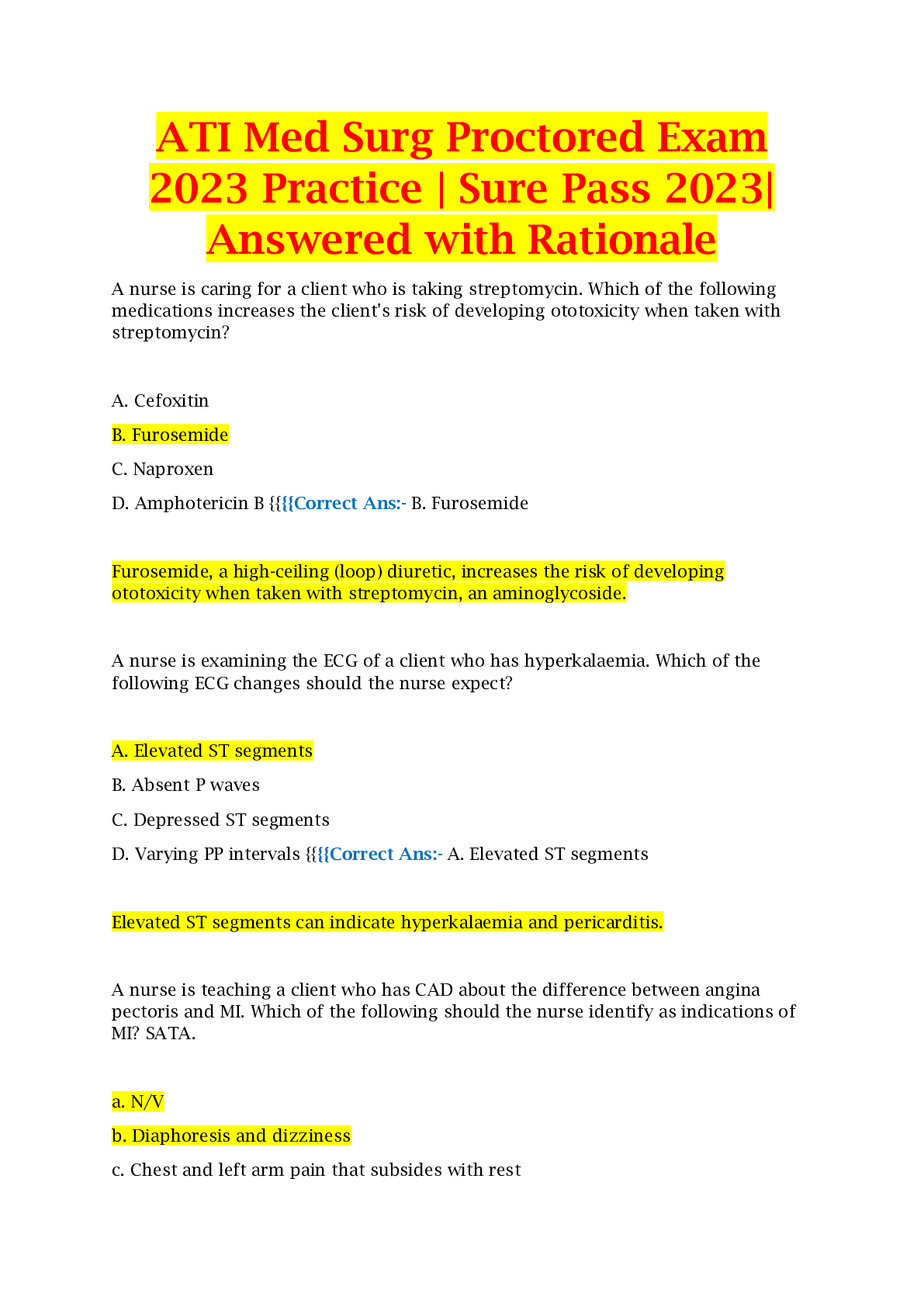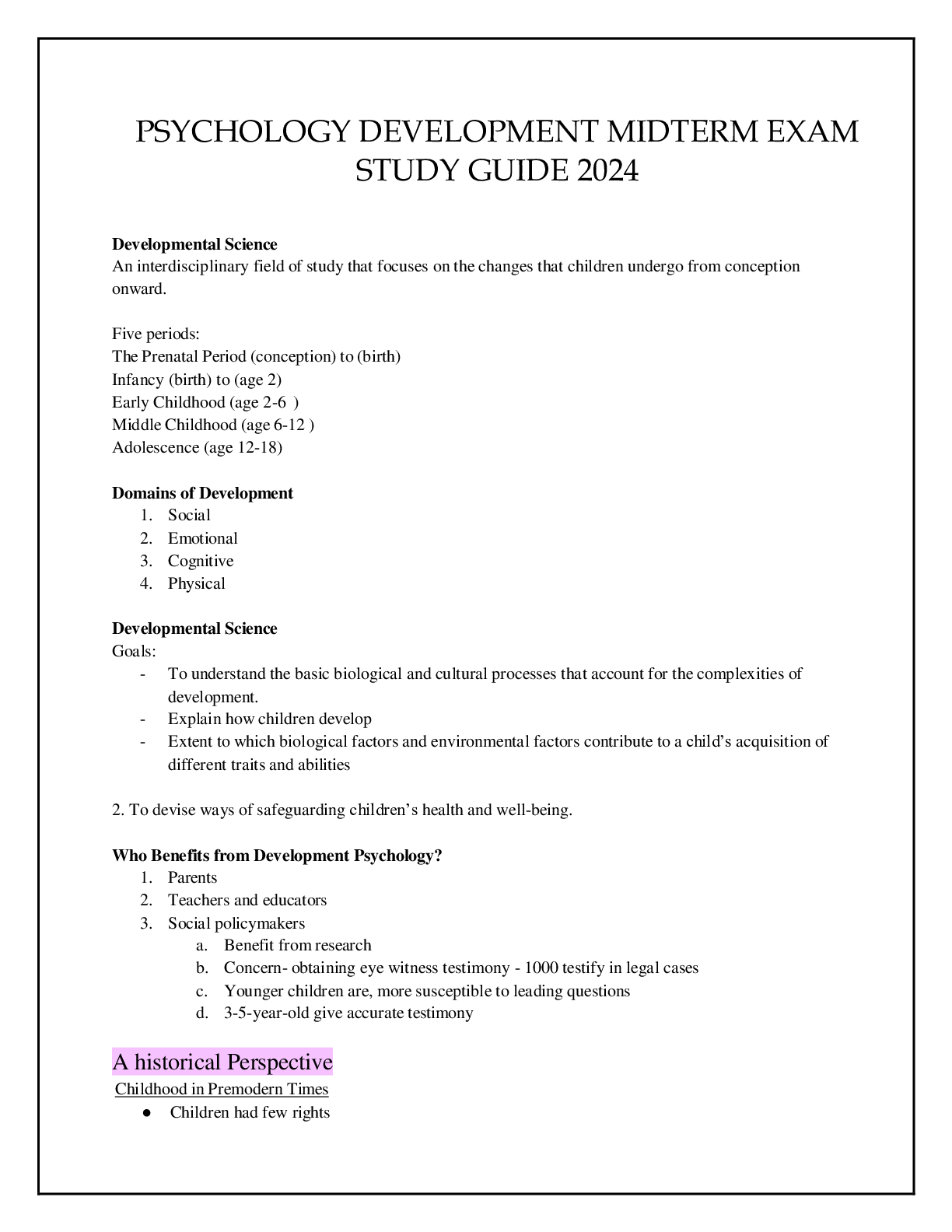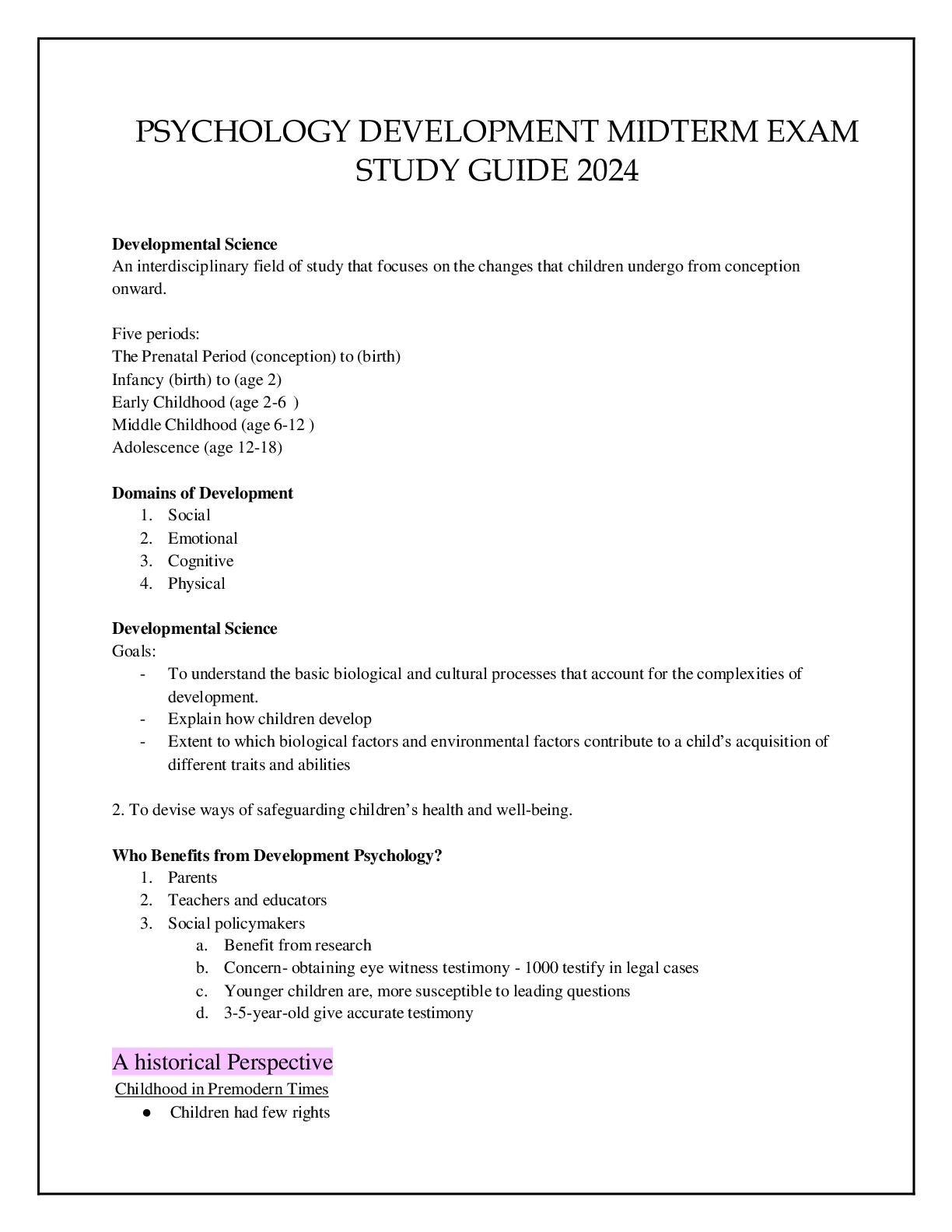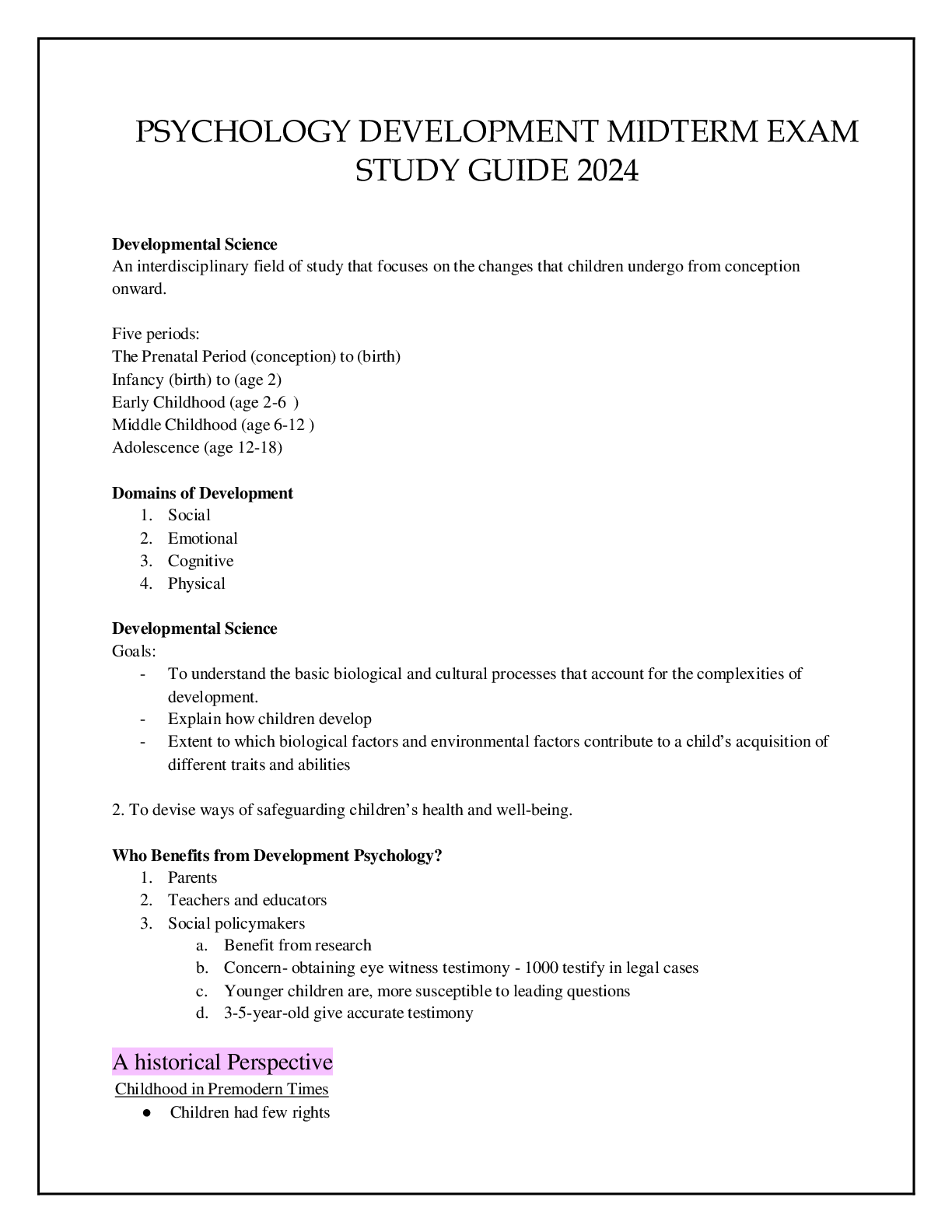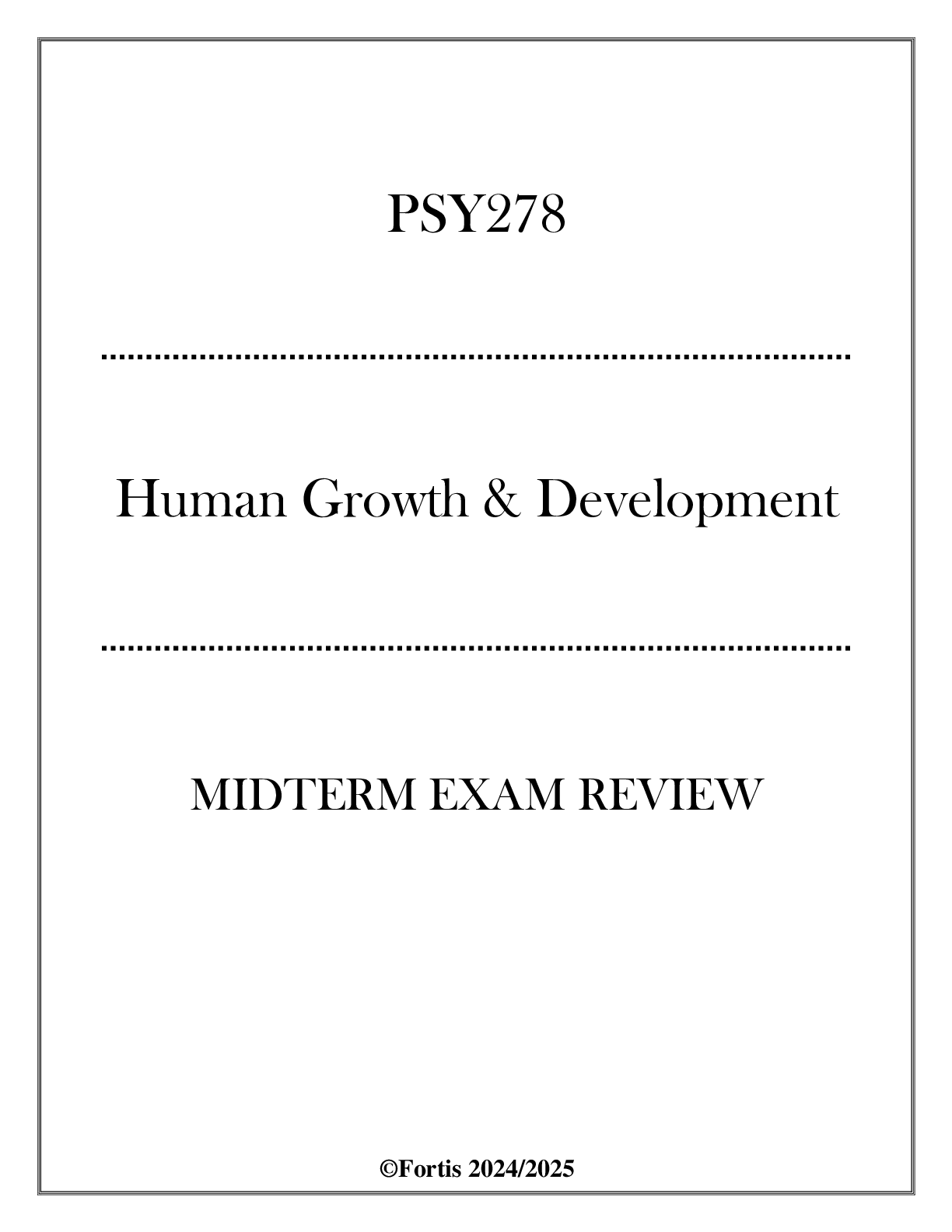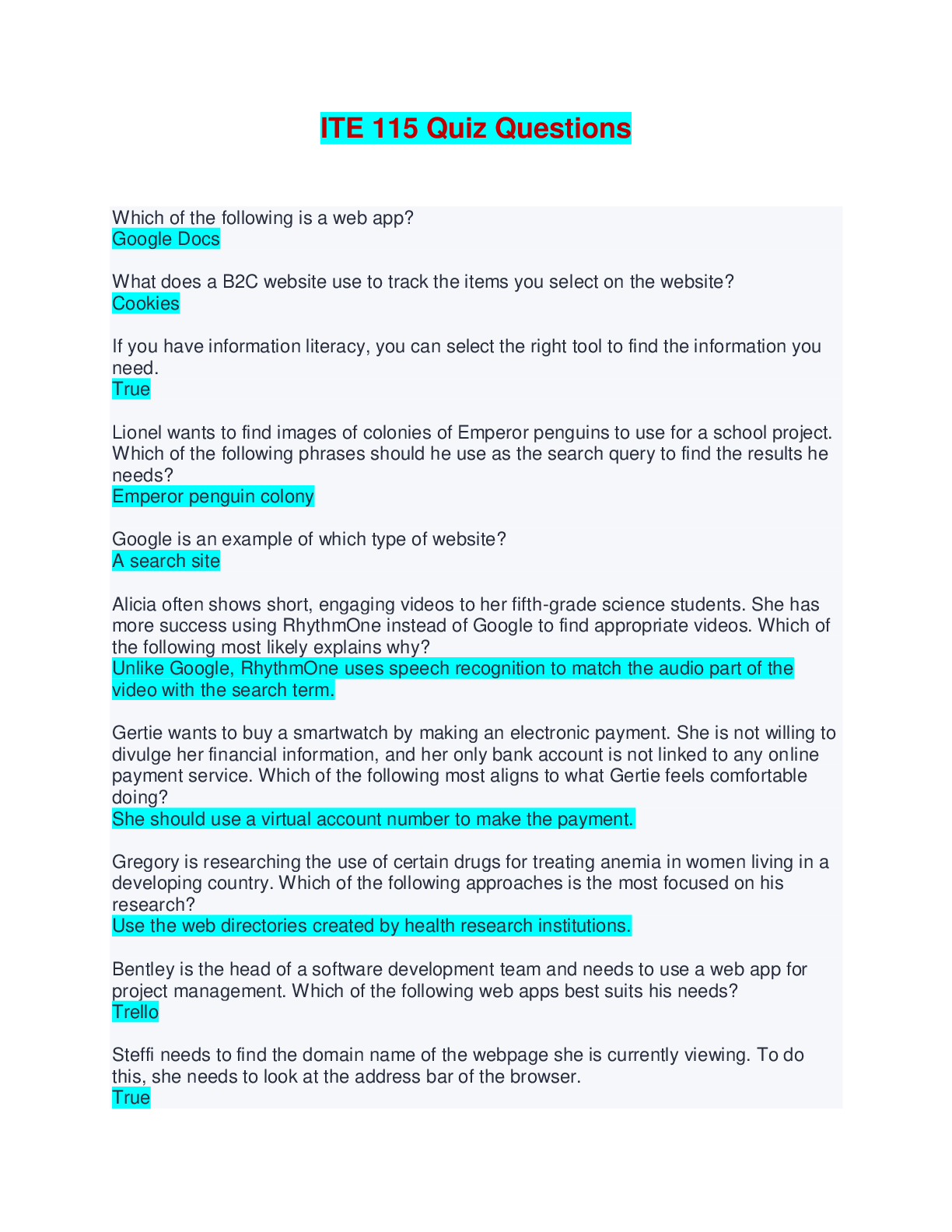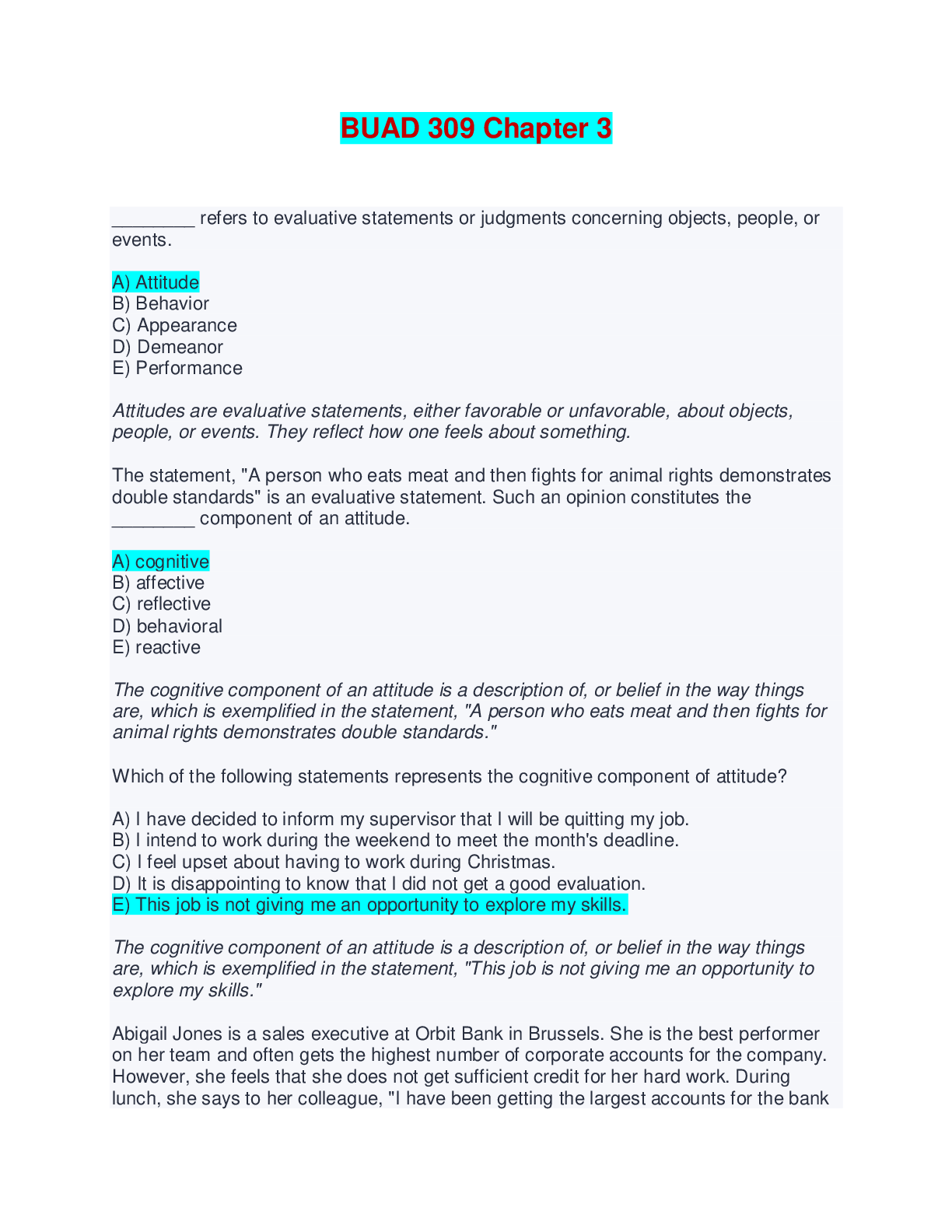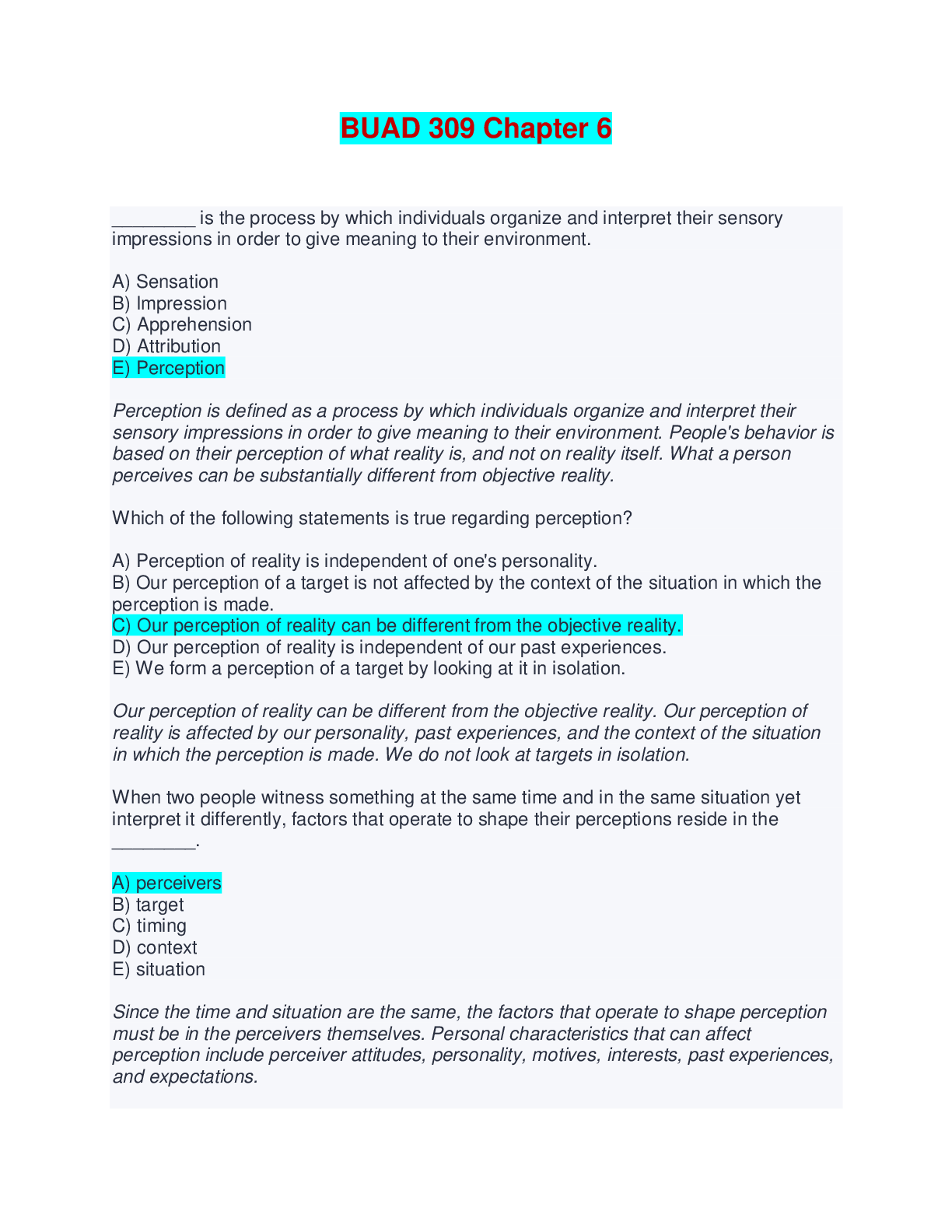Psychology > EXAM > 2024/2025 Lifespan Development Midterm Exam | Answered with complete solutions (All)
2024/2025 Lifespan Development Midterm Exam | Answered with complete solutions
Document Content and Description Below
2024/2025 Lifespan Development Midterm Exam | Answered with complete solutions Brian is 2.5 years old. He dwells in his own imaginary world and represents objects that are not present. He often scri... bbles patterns on walls that represent cloud, trees, birds, and so on. Brian's behavior indicates that he is in Piaget's _____ of cognitive development. symbolic function substage 18-month-old Alan hates spinach but says, "Yum!" when he sees his mother eating her favorite spinach casserole. This indicates that he recognizes that someone else may have different desires from his own. Kevin is just learning to walk. He can take a few steps by himself if he uses both hands to hold on to a piece of furniture for support. He can walk to the middle of a room only if one of his parents holds his hands. Which of the following represents the lower limit of Kevin's zone of proximal development (ZPD) for walking? Kevin walking alone by holding on to a piece of furniture with his hands Jim, a 3-year-old boy, gets a box of colorful blocks as a birthday gift from his uncle. He is excited to see the gift and demands to play with the blocks immediately. In the context of physical and cognitive development in early childhood, when playing with the blocks, Jim is most likely to place each block on top of the other with intense concentration. Toby is three years old. His parents are concerned because he always runs and jumps around. He cannot sit still. Even when watching his favorite cartoon on TV, he fidgets and wiggles. It is especially frustrating for his parents when Toby does not sit still through dinner. Which of the following should Toby's parents do? They should avoid panicking as Toby's behavior is normal for kids in his age group. Dorothy is enrolled in a preschool where she spends much of her time in unstructured activities. She plays with the toys she chooses, and her teacher acts as a facilitator rather than a director. Which of the following approaches is Dorothy's preschool using? the Montessori approach Russell conducts an experiment to study children's theory of mind. He selects participants and divides them into two groups. The first group consists of 3-year-olds, whereas the second group consists of 5-year-olds. Russell takes a box of crayons and places candies in them. He opens the box and shows it to both groups. Next, he asks the first group what a child who has never seen the box will think is actually inside the box. The group replies, "Candies!" To the same question, the second group replies, "Crayons!" This scenario illustrates that children younger than 4 years old do not understand that it is possible to have a false belief. Irene conducts a laboratory experiment to test the memory of children. She rapidly reads out a list of colors to three children aged 4, 6, and 13 years. The children are then asked to repeat the names of the colors. Irene notices that the 6-year-old and the 13-year-old are able to recall more colors than the 4-year-old. This experiment illustrates that memory span varies from one individual to another. Who among the following five-year-olds is most likely to be the tallest? Tyrone who is an African American, urban, middle-socioeconomic-status, firstborn boy. Over the past week, Walter has been learning to tie his shoelaces. Initially, his mother held his hands and worked his fingers through the process. Now that Walter is better at it, she only guides him verbally. This is an example of _____. Scaffolding Which of the following scenarios best represents Lev Vygotsky's view of mental and behavioral development? An instructor helps students with laboratory work showing them how to do things the students cannot do yet. Sandra is informed by a pediatrician that her four-year-old son, Manuel, has gained six pounds over the last one year. Sandra should be content that this is normal for Manuel's age. Patsy is a 5-year-old girl. She participates in a laboratory experiment in which random alphabets are rapidly read out to her. After 20 seconds, she is asked to recall those alphabets. In the context of information processing, this experiment has been conducted to assess Patsy's short-term memory. Olivia, 3-year-old girl, loves to play with her toy train. She names it Max and takes it with her everywhere. One day, while drinking milk, she spills the milk on the floor. To avoid being scolded, Olivia tells her mother that Max has spilled the milk. Another day, she blames Max for soiling her dress. In the context of cognitive development in early childhood, this scenario illustrates the concept of animism. Fred and Wayne are 4-year-olds. When they are together, they often wrestle, run, race, push, and shove each other. Although their activities often aggravate their parents, these activities will help the boys develop their gross motor skills. Three-year-old Ruth draws a picture with lavender, purple, and blue colors intermixed with green, yellow, and brown. "It is a boat in the ocean at sunset, with whales jumping all around it!" she explains to her teacher. Which of the following does this explain? the symbolic function substage Ted is in a Tools of the Mind classroom. His teacher guides him in planning his own message by drawing a line to stand for each word he says. Ted then repeats the message, pointing to each line as he says the word. Finally, he writes on the lines, trying to represent each word with some letters or symbols. This process is called scaffolding writing. Karla is a single mother of a 5-year-old son. She works in a bakery on a meager salary. Recently, she found out about a government-funded program that provides children from low-income families with the opportunity to acquire the skills important for success in school. The program aims to improve substandard education and alleviate poverty. Karla decides to apply for the program. The program being referred to in this scenario is Project Head Start Natalie is 4 years old. When she buttons her shirt, she talks to herself and describes the steps. This helps her in self-regulating and guiding her behavior. In the context of cognitive and physical development in early childhood, this scenario illustrates the concept of private speech. Irene is a 3-year-old girl. Her father takes her to a nearby park in the evening. In the context of the development of gross motor skills in children her age, identify an activity that Irene is mostly likely to do at the park. She will hop and jump just for the sheer delight of performing these activities. Dante is a 10-year-old boy who likes to play soccer during recess. One day, a friend teaches him a different set of rules about the game. Dante accepts the rules and now plays soccer in a new way. Dante is in which stage of moral development? autonomous morality Marjorie's son places last in a running race in his school. This makes him upset. He comes home and tells his mother about the result of the competition. His mother initially ignores him thinking that he will stop thinking about the competition. Later, when she sees that her son is still upset, she tries to distract him from the negative emotion by trying to change it. Marjorie's way of talking to her son about his negative emotions indicates that Marjorie is a(n) _____. emotion-dismissing parent Carl and Tulip are getting a divorce and want to know how they can best communicate the news to their young children. Ellen Galinsky and Judy David would suggest that the children be told that they are not the cause of the separation. Who among the following is most likely to be rejected by peers based on conformation to gender roles? a little boy playing with a doll Juan, a father of two children, tells his children, "In my house, my word is the law." He spanks his children frequently when they do not follow his rules. His children are fearful of Juan and try their best to avoid him when he is around. In the context of Diana Baumrind's parenting styles, Juan is best classified as a(n) authoritarian parent. Josh's mother makes his favorite food—burgers, fries, and pizza—every night for dinner. His mother lets Josh play as much as he wants to and study only when he feels like it and imposes no fixed bedtime. Josh's mom is most likely a(n) indulgent parent. Julie believes that Jason's accidental act of breaking 12 plates is worse than Peter intentionally breaking two plates. Julie can be best described as a(n) heteronomous moralist. Jerome, 6, and Hani, 10, get up early on Saturday morning to make "breakfast in bed" for their mother. While reaching for the bed tray in the back of the hall cabinet, they accidentally break their mother's favorite porcelain doll. Jerome knows that he's going to get into "big trouble." Hani tells him not to worry and that their mom would understand that it was an accident. In what stage would Jean Piaget categorize the moral reasoning of Jerome and Hani? Jerome—heteronomous morality; Hani—autonomous morality Barbara monitors her children's emotions. Her daughter is upset because she got reprimanded by her teacher. Barbara initially ignores her daughter's lamentations but then decides to try to change her daughter's emotions by saying that everyone gets reprimanded and that it is not a big deal. Barbara's approach of talking to her daughter about her negative emotions indicates that Barbara is a(n) _____. emotion-dismissing parent Misha was sent to his room for hitting his baby sister. Later, his mother talks to him about why he cannot treat his sister this way and about other, more acceptable ways for him to express his anger. Which parenting style does this exemplify? authoritative parenting From a young age, Karen has always been praised by her parents for her feminine behavior. Her parents reward her behavior by saying such statements as "Karen, you look very pretty in your frock." Her brother, on the other hand, is reprimanded for playing with Karen's dolls. In the context of social influences on gender development, this scenario is in accordance with the _____ of gender. social cognitive theory Twice each month, Gini helps to serve dinner at the "Community Table," a program that assists homeless people in the town. She brings her two children, aged nine and eleven, with her and talks to them about the need to share time, food, and kindness with others who are less fortunate. Social cognitive theorists would say that Gini's children are likely to develop moral behavior that includes helping others. Ben, a 12-year-old, judges the rightness or goodness of behavior by considering its consequences, not the intentions of the actor. In the context of Jean Piaget's theory of moral development, Ben will most likely be classified as a(n) heteronomous moralist. Damian's parents fail to provide for his basic needs; he is often unfed and dirty when he gets to school. This constitutes child neglect. Susan, a 5-year-old, thinks of justice and rules as unchangeable properties of the world, removed from the control of people. In the context of Jean Piaget's theory of moral development, Susan is most likely in the stage of moral reasoning known as heteronomous morality. Terence has a learning disability that involves difficulty in math computation. This disability is also known as developmental arithmetic disorder. On the other hand, Mindy, his classmate, finds it extremely challenging to read or spell simple words. Based on the given information, which of the following statements is true? Terence has dyscalculia, whereas Mindy has dyslexia. Alberta is a school teacher who introduces children to reading by teaching them a rhyme that goes "A for apple, A says ah, B for ball, B says buh," and so on. This exemplifies the _____ approach to reading instruction. Phonics Luis is able to organize coins in a row from the largest in size to the smallest. His newfound ability is called seriation. Paul is a gifted pianist. He was always highly motivated to learn and become an artist of consummate skill. According to his mother, Paul always showed an intense and obsessive interest in learning the instrument. He was always self-motivated and never needed to be "pushed" by his parents. What characteristic, as described by Ellen Winner, of gifted children is Paul exhibiting? a passion to master Sadie has a learning disability and is being educated in the least restrictive environment possible. This means that Sadie is placed in as regular a classroom as possible. Samuel is an 8-year-old boy. He has difficulty solving numerical problems. Hence, he is not able to solve any of the Math tests given by his teacher. His teacher gave him extra assignments and made him attend some remedial classes so that he can improve, but these did not help. His parents finally took him to a doctor, and the doctor diagnosed him with a learning disability called _____, or developmental arithmetic disorder. Dyscalculia Emily has the ability to think about things in novel and unusual ways; this allows her to come up with unique solutions to problems. This ability is called _____ thinking. creative Damon's teachers frequently complain that he disrupts his kindergarten class by fidgeting and moving about all the time. He does not pay any attention to what is being taught in class and behaves impulsively. Considering the presence of the tell-tale characteristics of inattention, hyperactivity, and impulsivity, Damon's pediatrician diagnosed him with _____ and put him on a combination of Ritalin and behavior therapy. ADHD Sabine is in the second grade. Compared to the other kids in her class, she finds it very challenging to read or spell simple words. Which of the following learning disabilities does Sabine suffer from? Dyslexia Colin does not get good grades on standardized tests and does not seem to be making an effort to improve his grades. He is more interested in martial arts and has earned a black belt in this field. In the context of Gardner's theories, Colin has _____. bodily-kinesthetic skills Sally's mental age is 12, but her chronological age is 10. Sally's IQ is _____. 120 Sandra is a nine-year-old girl. She was always the last student in class to finish assignments because she could only write slowly, and even then, her writing would be virtually illegible and riddled with spelling mistakes. Her teacher referred her to a psychologist who diagnosed her with a learning disability called dysgraphia. Although Casey scores only about average on standardized intelligence tests, she is street-smart and has excellent social skills and good common sense. Given a problem, Casey will try her best to arrive at a solution. Most of her friends and family appreciate this about her as she seems to be able to find ways to get things done on her own. In the context of Sternberg's theories, she has _____ intelligence. Practical Fiona, a ten-year-old girl, is an outstanding flautist and has an IQ of 140. Fiona is Gifted Jana's doctor is treating her for ADHD. Which of the following treatment plans would her doctor most likely recommend to achieve better results? a combination of stimulant medication and behavior management Mary thinks that she is a good person. This observation reflects Mary's self-esteem. Ten-year-old Jose finds that he needs to talk to Richard, his friend, in order to know whether his feelings about his own brothers and sisters are normal. Which friendship function does Richard provide in this case? social comparison In a survey, participants were asked whether buying a stolen television is morally right. More than 80 percent of the respondents said that it is morally wrong. However, 50 percent of the respondents admitted that they would buy the television if guaranteed that they would not be caught. In the context of the scenario, which of the following statements would most likely serve as a criticism for Lawrence Kohlberg's theory on moral development? Moral reasoning can sometimes be a shelter for immoral behavior. In the context of the developmental changes in emotions during the middle and late childhood years, who among the following children most likely exhibits the ability to suppress or conceal negative emotional reactions? Chris who has learned to tone down his anger when one of his classmates irritates him Darren is an active twelve-year-old boy. When his friend Simon cheats in a game, he tends to get irritated. However, Darren controls his anger and tries explaining to Simon why cheating is bad. Which developmental aspect is Darren displaying in his actions? self-regulation Mrs. Collins is a teacher who needs to develop a strategy for improving relations among ethnically diverse students. List some strategies that she may employ to obtain positive results. jigsaw classroom where students of different backgrounds are placed into cooperative groups; encourage students to have positive personal contact with diverse other students; reduce bias; view the school and community as a team to help support teaching efforts; and be a competent cultural mediator. The floods in the Midwest left 40,000 people homeless, and Keith's family is one of the families affected by the disaster. He is trying to help his son, Judd, cope with the tragedy. In this scenario, which of the following is a recommendation that Keith should follow to help Judd cope with the stress? Keith should allow Judd to retell the details of the event and be patient in listening to him. Erica, who has two children, marries Wayne. Wayne has a daughter from his previous marriage. After the union, their family will be considered a _____ stepfamily. Complex Most of Blanca's classmates call her a "bully," and many say that they "don't like her at all." Only few children consider her to be a friend. Which of the following is Blanca's probable peer status? rejected When Robert says, "I have brown eyes and black hair," it reflects Robert's self-concept. In the context of domain theory, which of the following scenarios best represents social conventional reasoning? Sheila raising her hand before speaking in class A person who is arrested for stealing company documents says, "Yes, I did steal the documents, and I am willing to go to jail for it. These documents prove that the company was engaging in a cover-up of the unsafe properties of its chemical. I think the public has a right to know about it." Lawrence Kohlberg would classify this person as using _____ reasoning. Postconventional Tapi believes that all human beings have certain inalienable rights that need to be protected. She believes that the current law in her country that prohibits interracial marriage is unfair and should be changed. In the context of Kohlberg's levels of moral thinking, which of the following describes Tapi's level of moral reasoning? Postconventional Mr. Trahan teaches English. He adopts a constructivist approach to learning. In his classroom, it is most likely that the students will be working in groups to discover the meaning of a poem. Johnny says he likes his best friend, Andy, because he is fun and talks about interesting things. Johnny also says that Andy encourages him to do his best and comforts him when he fails. Which of the following functions of children's friendships is Johnny most likely describing? stimulation and ego support Betty and Allen are part of a theatrical group, so they travel frequently. Their child, Cara, is an 11-month-old baby and travels everywhere with them. Even though Cara is usually comfortable with strangers, a full-time nanny, who Cara grew fond of in a day, helps take care of her when her parents are performing. Cara has a regular routine but easily adapts to new eating and sleeping habits whenever the family moves across states. According to Chess and Thomas, Cara would be classified as an easy child. Jenny is 4 years old. She becomes self-sufficient and develops school readiness skills. In this scenario, identify the developmental period that Jenny is most likely in. early childhood On your first day of class, Professor Red-Elk claims that for too long we have focused on the development of young children, especially infants. She argues that the development of adults and elderly people is just as important. This professor is articulating a(n) ________ approach. life-span Dr. Wong is a cognitive developmental theorist, so we know that he will stress the importance of ________ in understanding development. conscious thoughts A researcher is interested in the effect of exercise on stamina in elderly patients. The patients are randomly assigned to be in a high-exercise or low-exercise training program for eight weeks. At the end of the program, their stamina is measured by seeing how long they can walk comfortably on a treadmill. In this study, the dependent variable is the number of minutes on the treadmill. Monsena is an independent and adventurous child who likes to explore new places in her environment. However, her mother is overprotective and forbids Monsena from playing in the backyard or the garden of their house. Developmental psychologists would say that this discrepancy concerns goodness of fit. In the Strange Situation, Latoya basically ignored her mother, was not upset when she left the room, and did not seek her out when she returned. Mary Ainsworth would most likely classify Latoya as being insecure avoidant. Erin, a 90-year-old, is healthy and leads an active lifestyle. Most of her relatives have lived to an old age. Researchers have found that Erin's family carries genes related to stress resistance, immunity, and metabolism that help extend life by repairing and protecting body tissues. In this scenario, which of the following genes is most likely responsible for Erin living to an old age? longevity genes Lindsay's body does not produce enough insulin, causing abnormal metabolism of sugar. She is receiving insulin treatment. Lindsay has diabetes. Samantha is diagnosed with a genetic disorder. She suffers from glandular dysfunction that hinders mucus production. She has difficulty in breathing, and her digestion is hampered. She also has frequent lung infections and suffers from shortness of breath. In this scenario, which of the following genetic disorders is Samantha most likely suffering from? Cystic fibrosis [Show More]
Last updated: 8 months ago
Preview 4 out of 18 pages

Loading document previews ...
Buy this document to get the full access instantly
Instant Download Access after purchase
Buy NowInstant download
We Accept:

Also available in bundle (1)

LIFESPAN DEVELOPMENT EXAMS BUNDLE
LIFESPAN DEVELOPMENT EXAMS BUNDLE
By Ajay25 8 months ago
$29.5
4
Reviews( 0 )
$15.00
Can't find what you want? Try our AI powered Search
Document information
Connected school, study & course
About the document
Uploaded On
Oct 03, 2024
Number of pages
18
Written in
Additional information
This document has been written for:
Uploaded
Oct 03, 2024
Downloads
0
Views
22


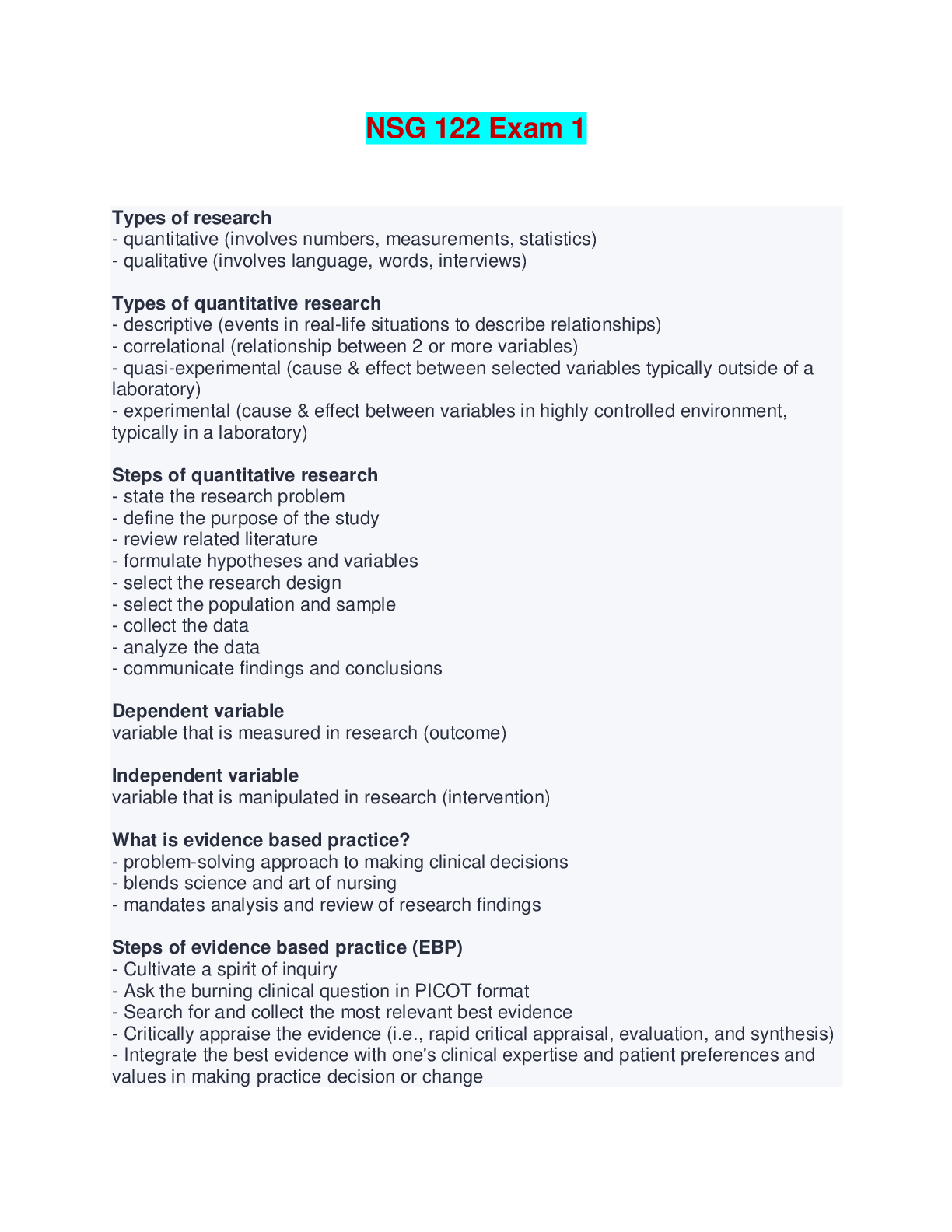

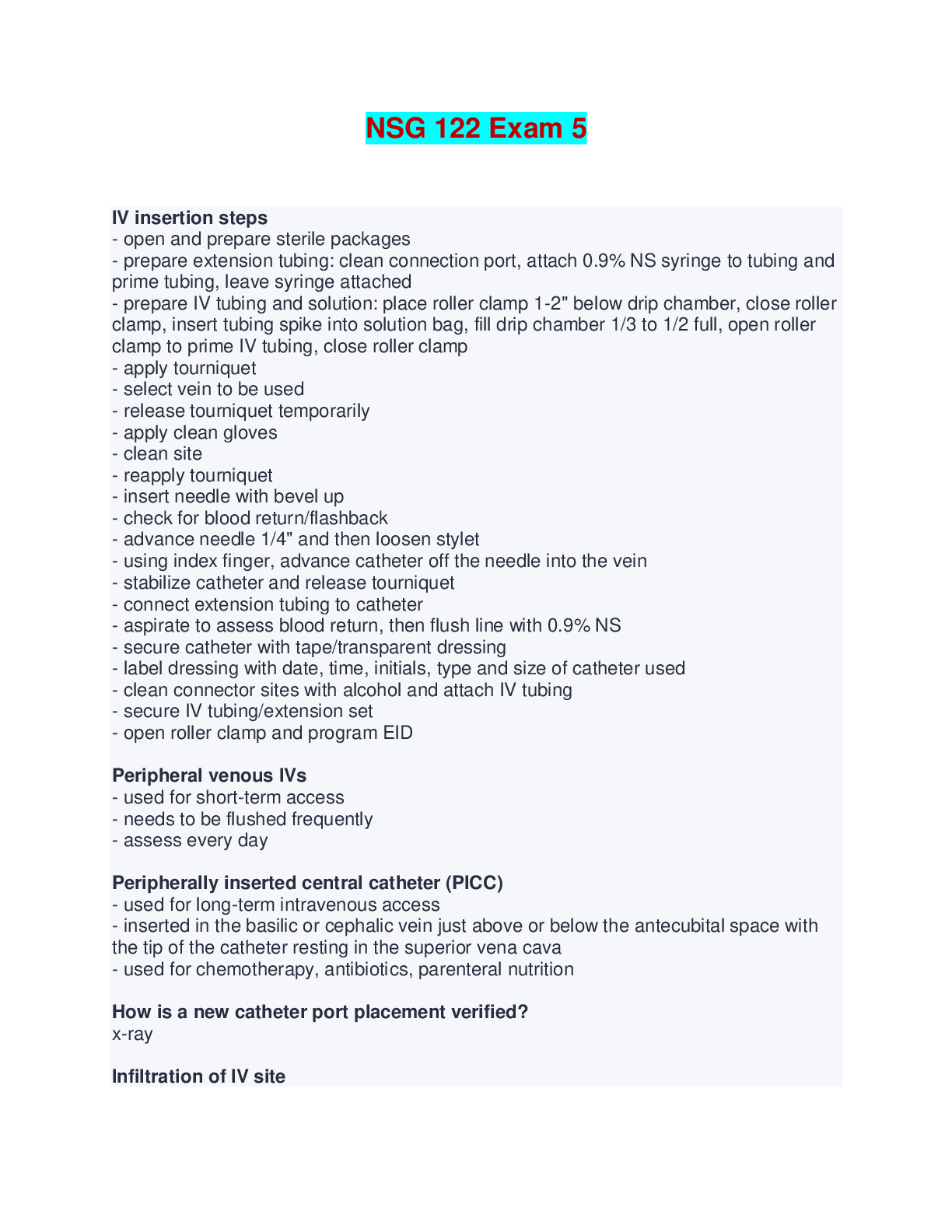

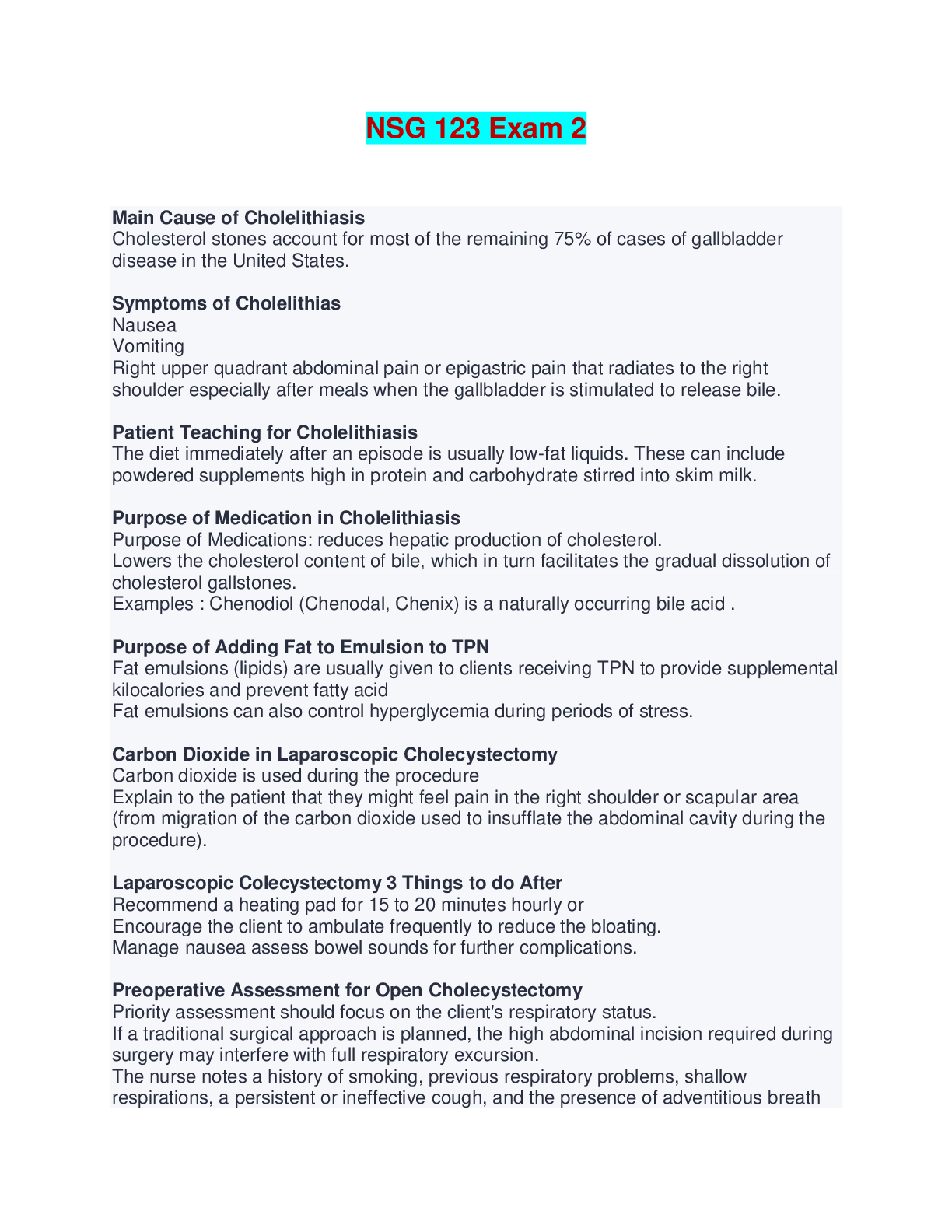
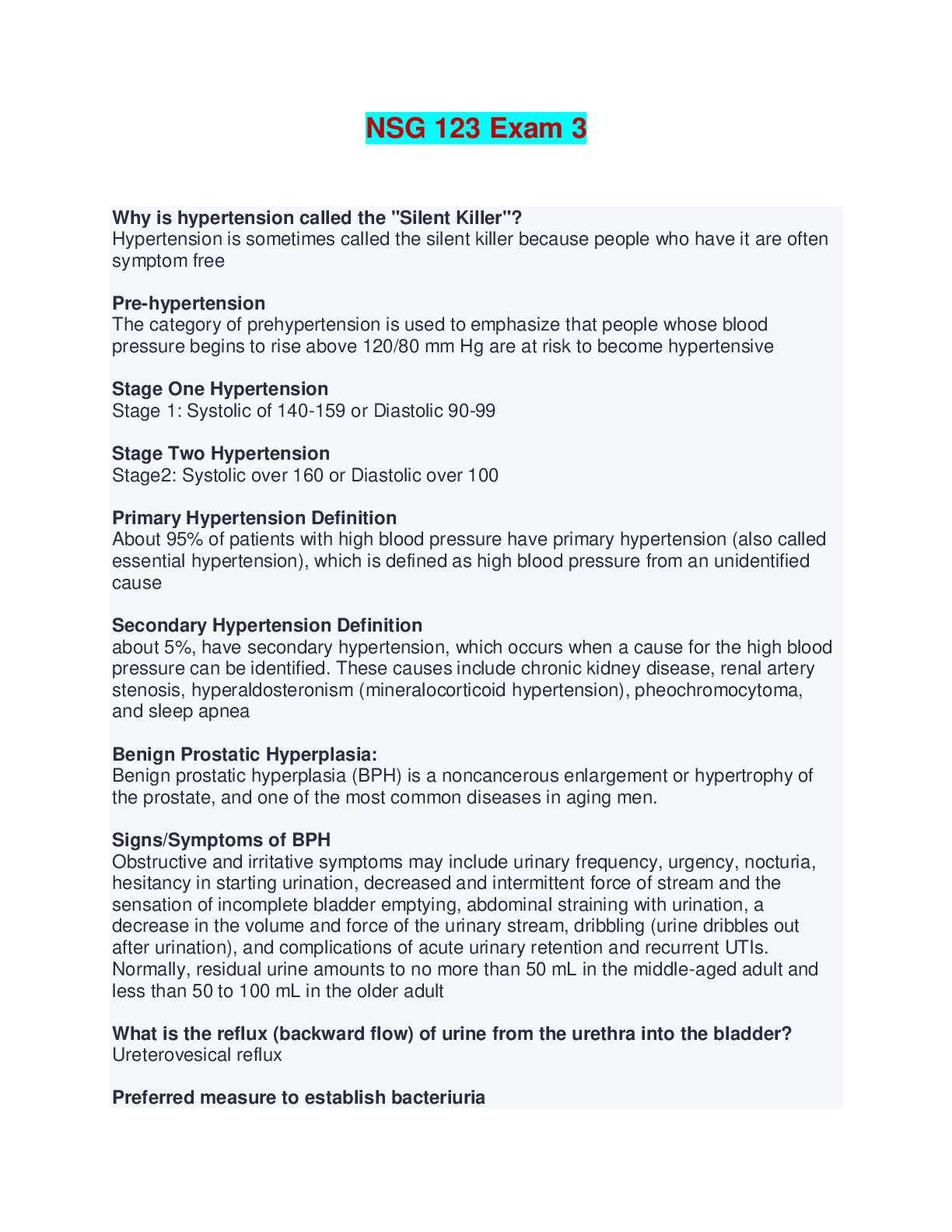
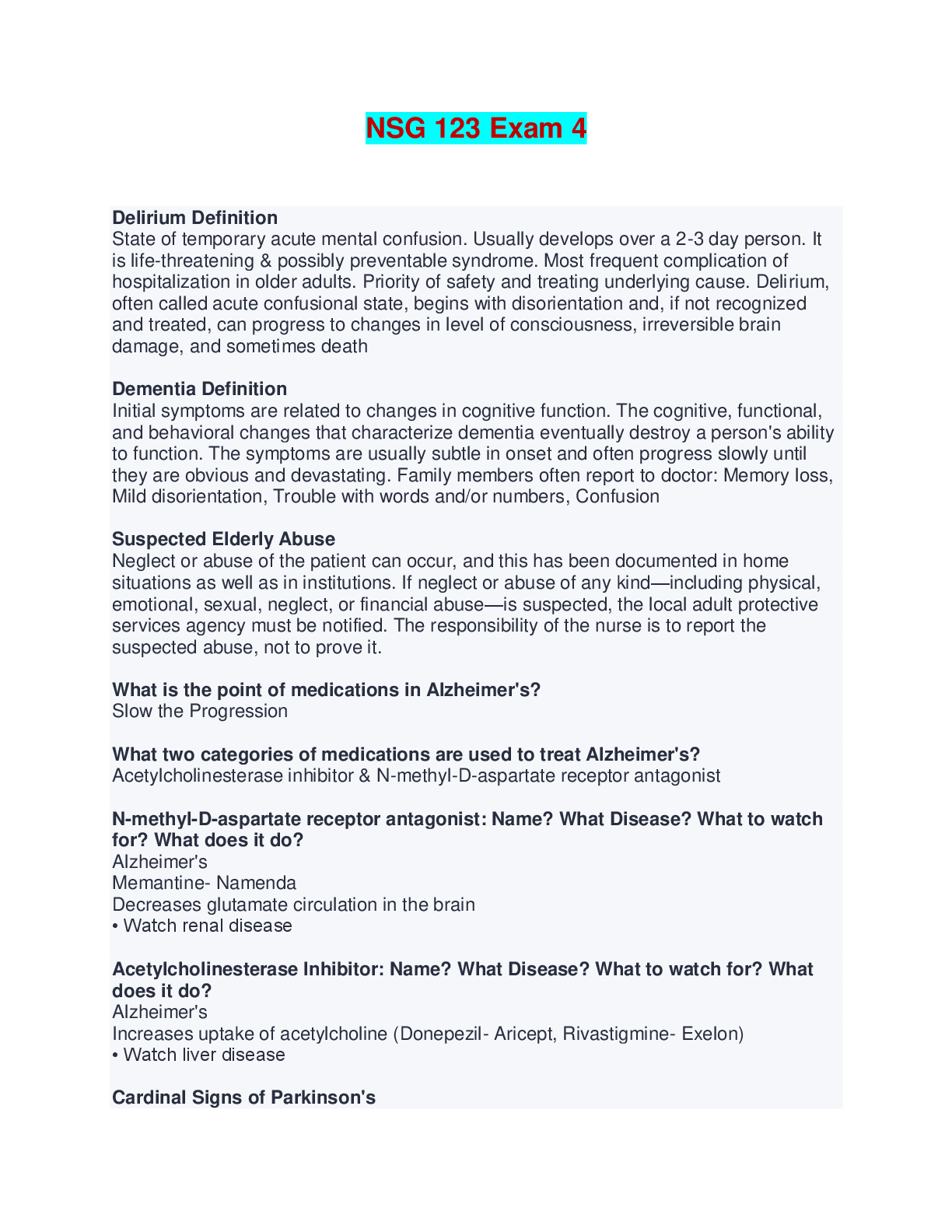
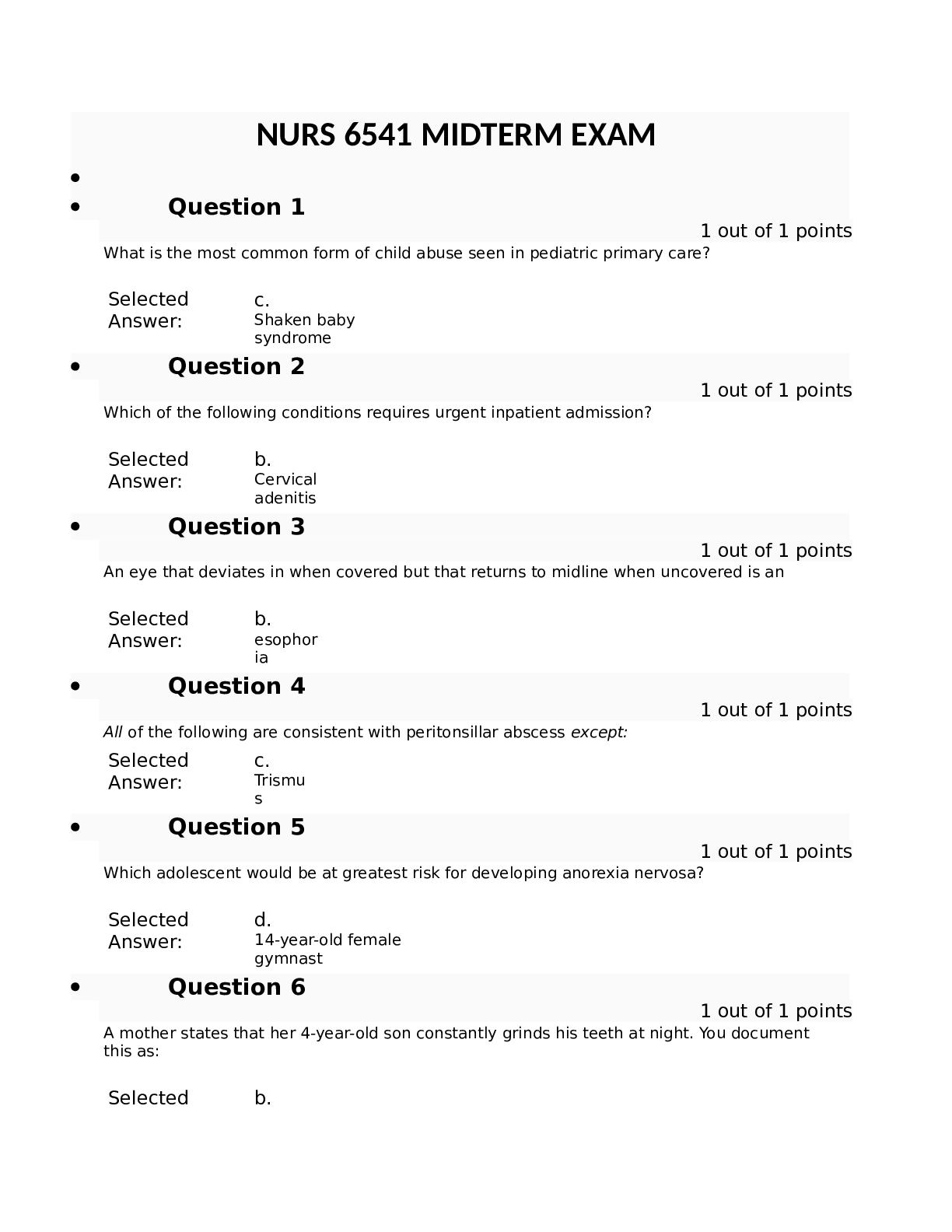
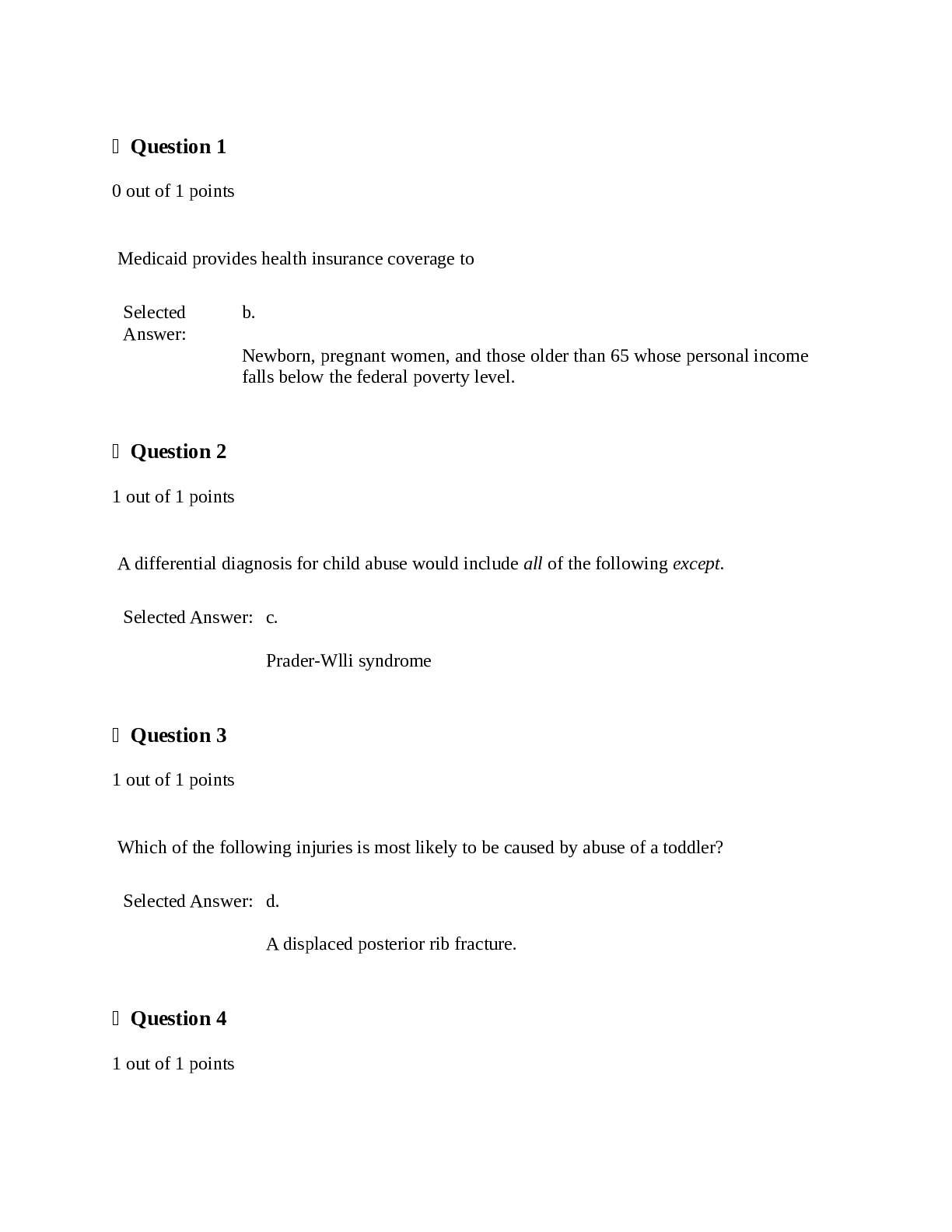

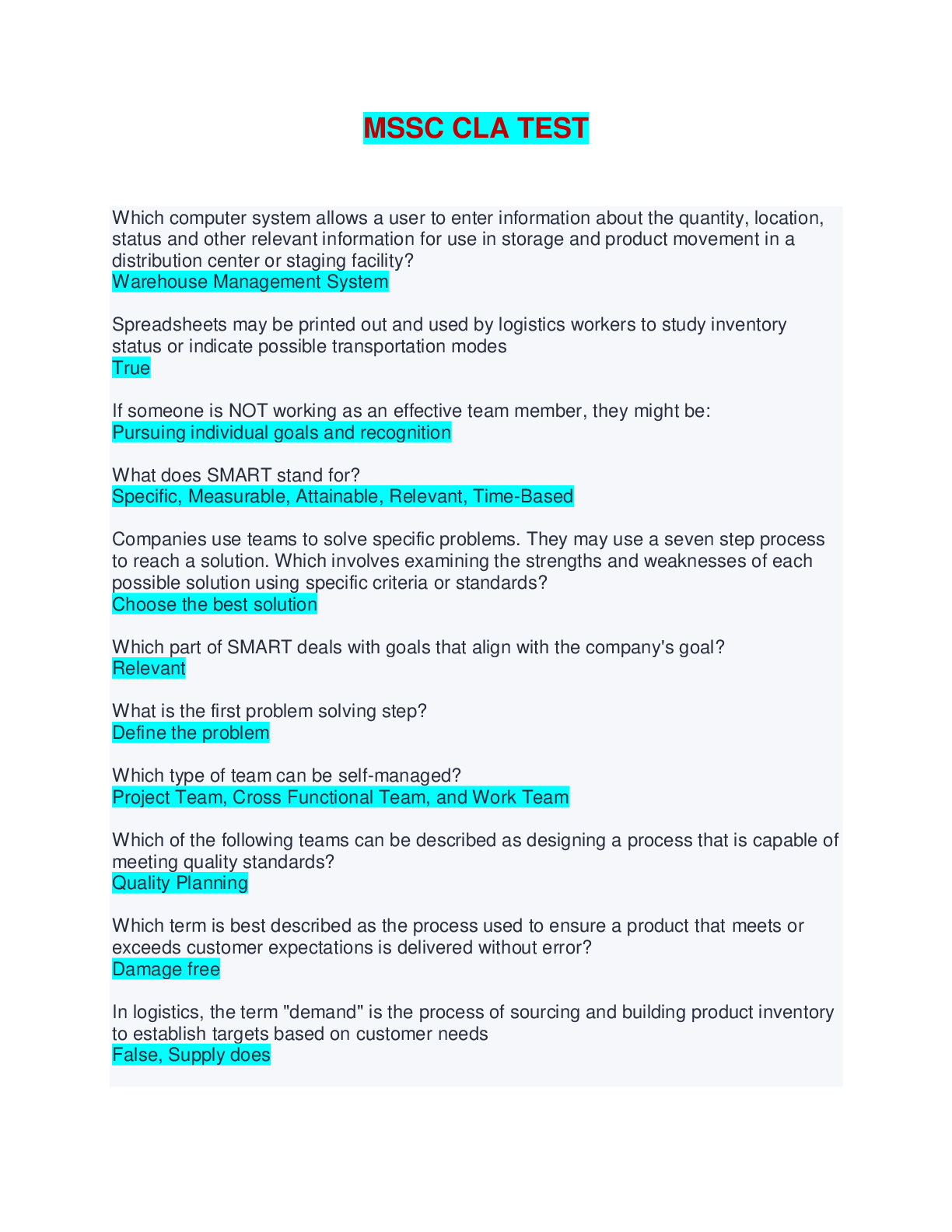
.png)
